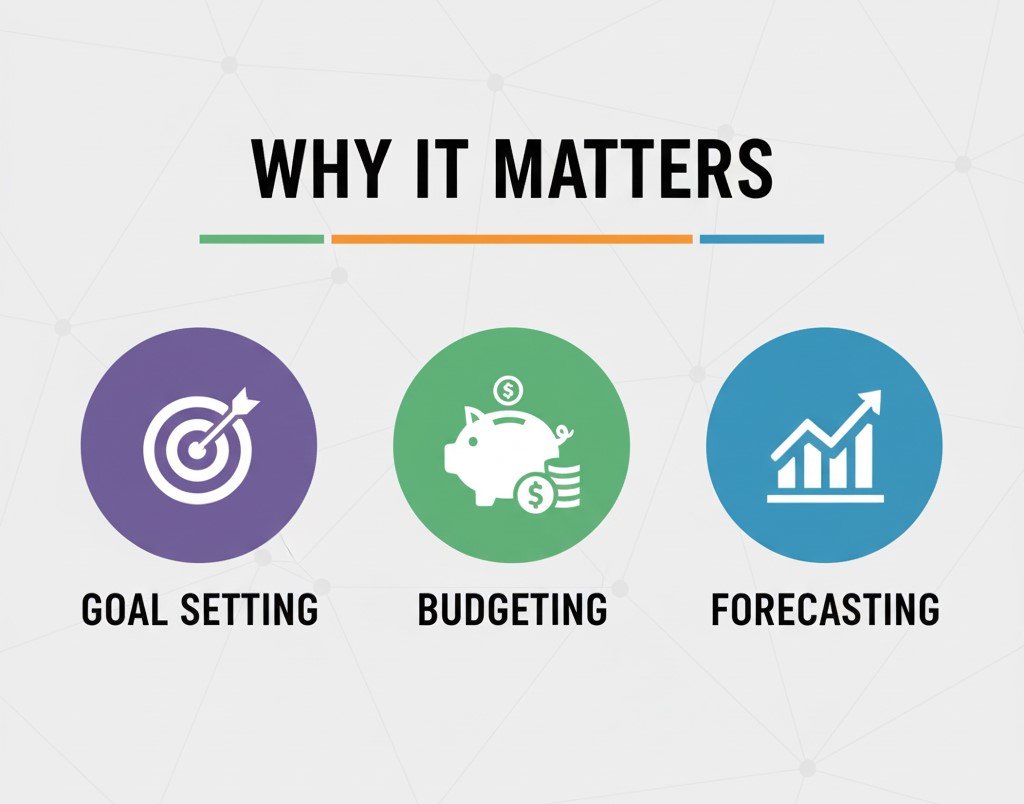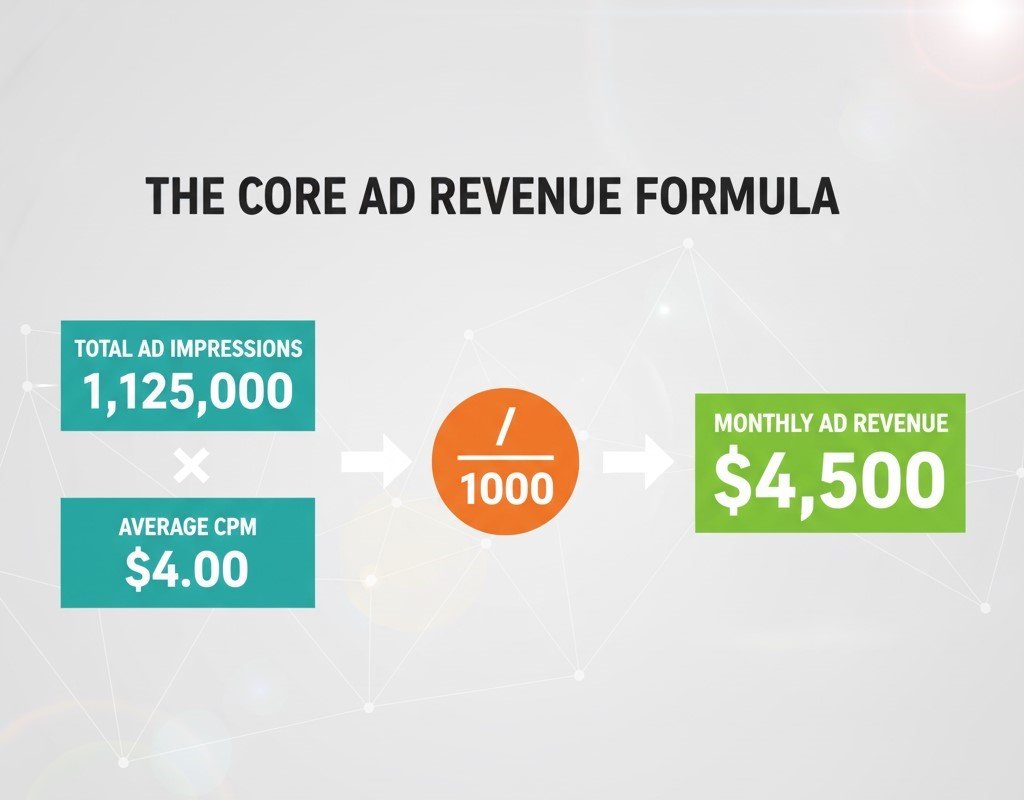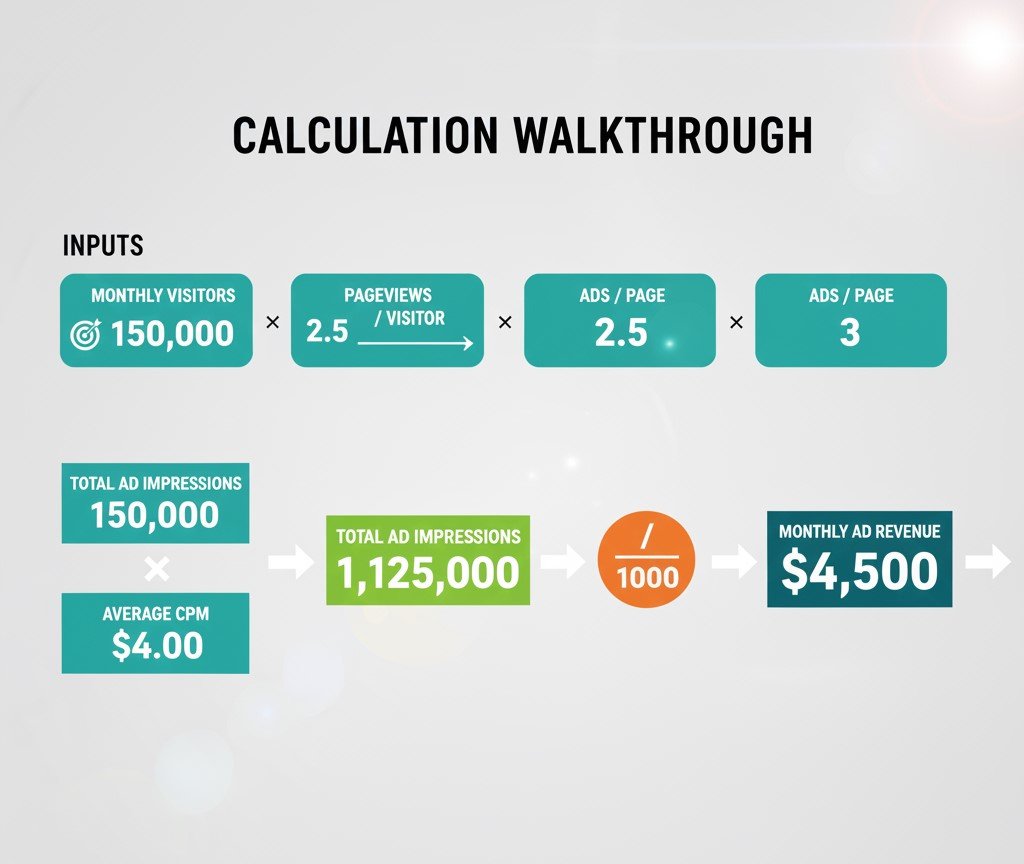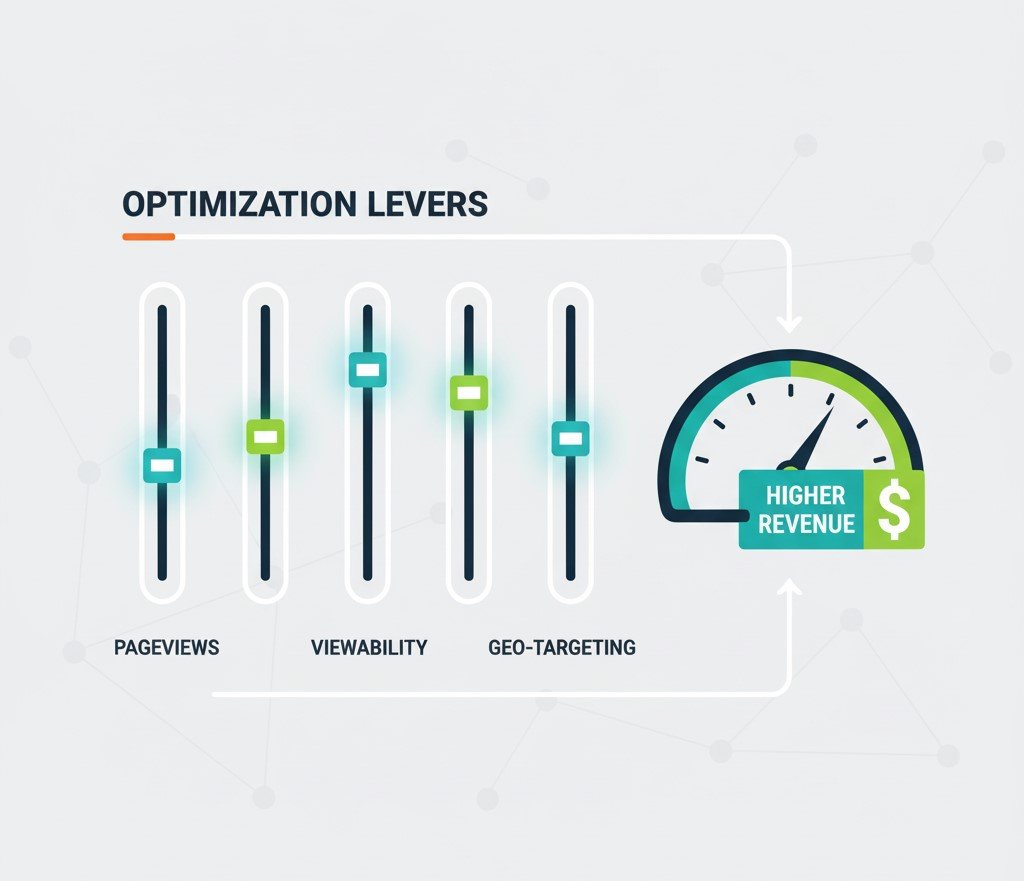If you run a website, blog, or online platform, one question is always on your mind: how much money am I really making from ads?
Display advertising remains one of the most consistent ways to monetize your web traffic. Yet, pinning down your exact earnings potential can feel like guesswork. Many publishers rely solely on the number their ad network reports at the end of the month, missing a crucial step: understanding the math behind it.
The good news is that the core ad revenue calculation isn’t complicated. It relies on a simple formula that ties together your website’s traffic with the price advertisers are willing to pay.
In this guide, we’ll walk you through the essential formula, break down the key terms, and provide a real-world example so you can confidently calculate and forecast your website ad earnings.
Why Calculating Your Ad Revenue Matters
For any digital publisher—whether you’re a single blogger or a media business—knowing how to calculate your revenue is fundamental to smart monetization.
It’s not just about tracking what you made; it’s about strategic planning. Understanding this formula empowers you to:
- Set Realistic Goals: You can model different traffic scenarios to figure out exactly how many visitors or pageviews you need to hit a certain revenue target.
- Compare Ad Networks: You gain an objective metric for comparing different ad network performance and making informed decisions about who gives you the best return.
- Identify Optimization Opportunities: The formula highlights which levers you can pull—like increasing ad units per page or boosting your average CPM.
Knowing your numbers moves you from hoping for the best to actively engineering your success.

Understanding the 3 Core Metrics (The Ingredients)
Before we dive into the math, we need to understand the three essential ingredients that make up the website ad revenue formula. If you understand these, the rest is easy.
Metric 1: Total Ad Impressions
An impression is counted every time an ad is displayed to a user. This is the total inventory you have to sell to advertisers. The total number of ad impressions is calculated based on three factors from your website analytics:
- Monthly Visitors: The total number of unique people visiting your site per month.
- Pageviews per Visitor: The average number of pages each visitor clicks through on your site.
- Ads per Page: The number of ad slots you display on each page (e.g., one ad in the header, one in the sidebar, two within the content).
Formula for Impressions:
$$\text{Total Monthly Impressions} = \text{Monthly Visitors} \times \text{Pageviews per Visitor} \times \text{Ads per Page}$$
Metric 2: CPM (Cost Per Mille)
CPM stands for Cost Per Mille—”Mille” being the Latin word for a thousand. It is the amount an advertiser pays for every 1,000 times their ad is displayed.
This is the pricing model used in programmatic advertising. Your average CPM rate is the market price for your audience’s attention.
Factors that Affect Your CPM:
- Geographic Location: Traffic from Tier 1 countries (like the US, UK, Canada, and Australia) almost always commands a higher CPM than traffic from other regions.
- Niche/Vertical: Finance, technology, and B2B content often have high CPMs because the audience is high-value and transactional.
- Seasonality: CPMs spike in the fourth quarter (Q4) due to holiday shopping and drop significantly in January.
Metric 3: The 1,000 Divisor
This isn’t a metric, but it’s a critical part of the formula. Because the CPM is priced per thousand impressions, we have to divide the total number of impressions by 1,000 to match the units. Simple, but easy to forget!

The Official Ad Revenue Calculation Formula
Now that you have the inputs, the final formula to estimate your online advertising income is straightforward:
$$\text{Monthly Ad Revenue} = \frac{\text{Total Ad Impressions} \times \text{Average CPM}}{\text{1,000}}$$
Let’s put this to work with a real-world example to show you how easy it is.
Step-by-Step Example Calculation
Imagine you run a cooking blog, and you have the following metrics for the last 30 days:
| Input Metric | Value |
| Monthly Visitors | 150,000 |
| Pageviews Per Visitor | 2.5 |
| Ads Per Page | 3 |
| Average CPM | $4.00 |
Step 1: Calculate Total Ad Impressions
First, we figure out your total inventory (impressions) available to advertisers:
$$150,000 \text{ Visitors} \times 2.5 \text{ Pageviews} \times 3 \text{ Ads per Page} = 1,125,000 \text{ Total Impressions}$$
Step 2: Calculate the Monthly Ad Revenue
Now, we plug the total impressions and the average CPM into the main formula:
$$\text{Monthly Revenue} = \frac{1,125,000 \times \$4.00}{1,000}$$
$$\text{Monthly Revenue} = \frac{4,500,000}{1,000}$$
$$\text{Monthly Revenue} = \$4,500$$
Conclusion: Based on the formula, your estimated monthly ad earnings are $4,500.

The Difference Between CPM and eCPM (Don’t Get Confused!)
As you dive deeper into digital publisher monetization, you will quickly encounter two similar-sounding terms: CPM and eCPM. Using them interchangeably is one of the most common mistakes publishers make.
| Metric | Stands For | Used By | What It Represents |
| CPM | Cost Per Mille | Advertisers | The price an advertiser pays for 1,000 impressions. |
| eCPM | Effective Cost Per Mille | Publishers | The total revenue a publisher earns per 1,000 impressions, across all ad types (CPM, CPC, etc.). |
Why the difference matters: Your network might be running a mix of payment models (CPC, CPA, and CPM). The eCPM is the effective, normalized revenue metric that tells you the true value of your inventory, regardless of the campaign type.
If you’re calculating your actual revenue, always look at your average eCPM. It gives you a more accurate picture of your overall ad network performance.
Three Ways to Instantly Increase Your Ad Revenue
The calculation formula reveals that you really only have two high-impact variables you can control: the number of impressions you generate, and the quality of those impressions (which drives a higher CPM).
Here are three actionable tips for maximizing your ad income:
Tip 1: Boost Pageviews Per Visitor (Internal Linking Strategy)
Since Total Impressions relies directly on Pageviews per Visitor, keeping users on your site longer instantly increases your inventory.
- Action: Implement strong internal linking by suggesting related posts within your content. Use “Recommended Reading” sections prominently after every article. The goal is to maximize the time the user spends on your domain.
Tip 2: Optimize Ad Placement for Viewability
Advertisers pay more for ads that are actually seen. Viewability is a major factor in driving a higher average CPM.
- Action: Ensure your ads are placed in highly visible areas, such as above the fold (the part of the page seen without scrolling) and within the content itself. Test sticky sidebars or footer ad units, as these maintain viewability as the user scrolls.
Tip 3: Target Higher-Value Traffic (High CPM Keywords)
While you can’t change where your audience lives, you can adjust your content strategy to attract a more valuable audience.
- Action: Do keyword research to target subjects that align with high-value advertiser niches (e.g., investment planning, SaaS software reviews, luxury home décor). Advertisers in these verticals typically have larger budgets and are willing to pay a higher CPM for highly relevant traffic. This is a core part of SEO and programmatic advertising optimization.

Use the AdRevHub Calculator for Instant Estimates
Manually calculating ad revenue across different scenarios is helpful for learning, but it’s time-consuming. That’s why we built the AdRevHub Ad Revenue Calculator.
The tool uses this exact formula, allowing you to quickly test monetization scenarios—from adjusting your current CPM to seeing the impact of doubling your monthly traffic. It’s the fastest way to get an accurate, real-time forecast for your website.
Stop guessing and start planning. Plug in your traffic metrics and estimated CPM to see your current potential today.
Frequently Asked Questions (FAQs)
Q: What is a realistic average CPM to use for my website?
Average CPM varies widely based on your niche and traffic quality. For general lifestyle or hobby blogs, a realistic average is often $1.50 to $5.00. High-value niches like finance, B2B, or health can see average CPMs well over $10.00 to $20.00, especially with Tier 1 traffic.
Q: Why does my actual payment not exactly match the calculated revenue?
The formula provides an excellent estimate website ad revenue. Your final payment can differ due to factors not included in the basic formula, such as fill rate (the network didn’t have an ad for every slot), ad viewability thresholds, ad block usage by your audience, and fraud filtering.
Q: Does calculating ad revenue include affiliate or sponsorship income?
No. The ad revenue calculation formula is specifically designed to estimate income from display ads based on the CPM model. Income from affiliate links, direct sponsorships, or product sales are entirely separate revenue streams and should be tracked with different formulas.
Q: How can I double my ad revenue without significantly increasing my traffic?
Focus on the multiplier metrics: increase your Pageviews Per Visitor (keep users engaged) and work to raise your effective CPM (eCPM) through better ad placements, higher viewability, and potentially moving to a premium ad network once your traffic warrants it.
Final Thoughts and Next Steps
Understanding the ad revenue formula is the first step toward taking control of your website’s financial future. It’s the difference between being a passive recipient of payments and an active strategist working to maximize every impression.
By breaking down your traffic into core metrics, you reveal the clear path to higher earnings. Don’t wait for the next payment cycle to start optimizing.
Use the free AdRevHub calculator right now. Plug in your current numbers to establish a baseline, then adjust one variable at a time (like a target CPM increase) to visualize your true revenue potential. Knowledge is power, and in the world of digital publishing, it translates directly to profit.